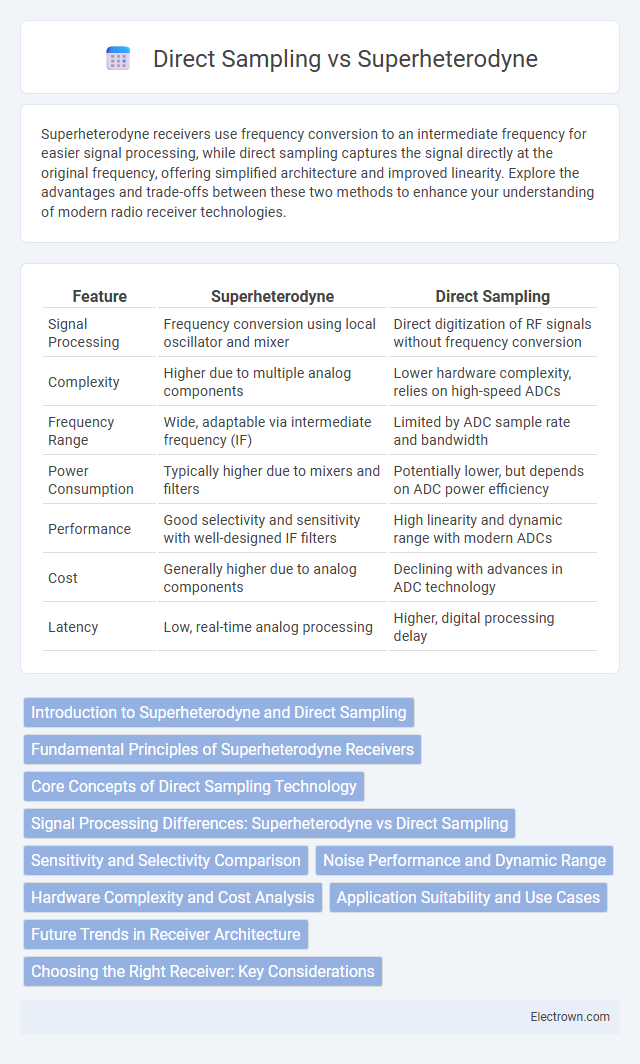Superheterodyne receivers use frequency conversion to an intermediate frequency for easier signal processing, while direct sampling captures the signal directly at the original frequency, offering simplified architecture and improved linearity. Explore the advantages and trade-offs between these two methods to enhance your understanding of modern radio receiver technologies.
Table of Comparison
| Feature | Superheterodyne | Direct Sampling |
|---|---|---|
| Signal Processing | Frequency conversion using local oscillator and mixer | Direct digitization of RF signals without frequency conversion |
| Complexity | Higher due to multiple analog components | Lower hardware complexity, relies on high-speed ADCs |
| Frequency Range | Wide, adaptable via intermediate frequency (IF) | Limited by ADC sample rate and bandwidth |
| Power Consumption | Typically higher due to mixers and filters | Potentially lower, but depends on ADC power efficiency |
| Performance | Good selectivity and sensitivity with well-designed IF filters | High linearity and dynamic range with modern ADCs |
| Cost | Generally higher due to analog components | Declining with advances in ADC technology |
| Latency | Low, real-time analog processing | Higher, digital processing delay |
Introduction to Superheterodyne and Direct Sampling
Superheterodyne receivers use frequency mixing to convert a received signal to a fixed intermediate frequency (IF) for easier processing, enhancing selectivity and sensitivity in radio communication systems. Direct Sampling, also known as direct conversion or zero-IF sampling, digitizes the incoming radio frequency (RF) signal directly using high-speed analog-to-digital converters (ADCs), simplifying architecture and improving flexibility in software-defined radios. Both techniques have distinct advantages depending on application requirements such as bandwidth, complexity, and power consumption.
Fundamental Principles of Superheterodyne Receivers
Superheterodyne receivers operate by converting the received radio frequency (RF) signal to a lower intermediate frequency (IF) through mixing with a locally generated oscillator signal, allowing for easier filtering and amplification. This frequency translation improves selectivity and sensitivity by isolating desired signals from noise and interference before demodulation. Understanding these fundamental principles helps you appreciate why superheterodyne designs remain prevalent in high-performance radio and communication systems.
Core Concepts of Direct Sampling Technology
Direct Sampling technology captures radio signals by converting them directly from the radio frequency (RF) spectrum to digital form using high-speed analog-to-digital converters (ADCs), eliminating intermediate frequency stages. This method enhances signal fidelity and reduces complexity compared to Superheterodyne receivers, which rely on multiple frequency conversion steps. Your choice of Direct Sampling systems ensures more accurate spectrum analysis and improved dynamic range in modern communication applications.
Signal Processing Differences: Superheterodyne vs Direct Sampling
Superheterodyne receivers convert the input signal to one or more intermediate frequencies (IF) through mixing and filtering stages, enabling selective amplification and improved signal-to-noise ratio before final demodulation. Direct sampling receivers digitize the incoming RF signal immediately with high-speed analog-to-digital converters (ADCs), relying on digital signal processing (DSP) algorithms for filtering and demodulation, reducing analog component complexity. Your choice between these architectures impacts processing latency, hardware complexity, and susceptibility to spurious signals or image distortion in signal reception.
Sensitivity and Selectivity Comparison
Superheterodyne receivers typically offer superior sensitivity and selectivity by utilizing intermediate frequency (IF) filtering to enhance signal detection and reduce noise. Direct sampling relies on high-speed analog-to-digital converters (ADCs) and digital signal processing, which can provide flexibility but may struggle with dynamic range and selectivity compared to superheterodyne designs. Your choice between these architectures affects the ability to detect weak signals and discriminate closely spaced frequencies in challenging radio environments.
Noise Performance and Dynamic Range
Superheterodyne receivers typically offer superior noise performance by utilizing intermediate frequency (IF) filtering, which effectively minimizes noise and interference before signal demodulation. Direct sampling systems rely on high-speed analog-to-digital converters (ADCs) and advanced digital signal processing, providing excellent dynamic range but often facing challenges with increased noise due to the absence of frequency conversion stages. Your choice between the two should consider whether low noise floor (favoring superheterodyne) or broad dynamic range with flexible processing (favoring direct sampling) aligns better with your application requirements.
Hardware Complexity and Cost Analysis
Superheterodyne receivers require multiple analog components such as mixers, local oscillators, and intermediate frequency filters, leading to higher hardware complexity and increased manufacturing costs. Direct sampling receivers simplify the architecture by digitizing the RF signal directly with high-speed analog-to-digital converters, reducing hardware parts and potentially lowering costs. Your choice between these technologies should consider the trade-off between analog complexity and the cost of high-performance digital components.
Application Suitability and Use Cases
Superheterodyne receivers excel in applications requiring high selectivity and sensitivity, such as commercial AM/FM radios, broadcast receivers, and complex communication systems, due to their frequency conversion process that improves signal processing. Direct sampling receivers are preferred in software-defined radios, spectrum analyzers, and modern wireless devices where wideband signal capture and simplified circuitry enable versatile and high-speed digital signal processing. Each approach suits different use cases based on system complexity, cost constraints, and performance requirements in signal fidelity and bandwidth.
Future Trends in Receiver Architecture
Future trends in receiver architecture emphasize integrating advanced digital signal processing with superheterodyne designs to enhance selectivity and sensitivity while reducing size and power consumption. Direct sampling technology is rapidly advancing due to improvements in high-speed analog-to-digital converters, enabling simpler architectures with fewer analog components and better linearity. Your choice between superheterodyne and direct sampling receivers will depend on balancing cost, complexity, and performance requirements amid evolving semiconductor and DSP capabilities.
Choosing the Right Receiver: Key Considerations
Choosing the right receiver involves evaluating factors such as signal fidelity, complexity, and cost efficiency between superheterodyne and direct sampling architectures. Superheterodyne receivers excel in sensitivity and selectivity due to intermediate frequency stages, while direct sampling offers simpler design and faster signal processing by digitizing signals immediately. Your decision should align with your application's performance requirements, budget constraints, and ease of integration.
Superheterodyne vs Direct Sampling Infographic

 electrown.com
electrown.com